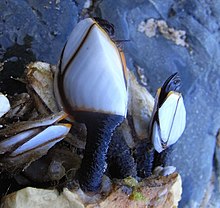Lepas anatifera
| Lepas anatifera | |
|---|---|
 |
|
| Scientific classification | |
| Kingdom: | Animalia |
| Phylum: | Arthropoda |
| Subphylum: | Crustacea |
| Class: | Maxillopoda |
| Infraclass: | Cirripedia |
| Order: | Pedunculata |
| Family: | Lepadidae |
| Genus: | Lepas |
| Species: | L. anatifera |
| Binomial name | |
|
Lepas anatifera Linnaeus, 1758 |
|
Lepas anatifera, commonly known as the pelagic gooseneck barnacle or smooth gooseneck barnacle, is a species of barnacle in the family Lepadidae. These barnacles are found, often in large numbers, attached by their flexible stalks to floating timber, the hulls of ships, piers, pilings, seaweed and various sorts of flotsam.
The body or capitulum of Lepas anatifera is supported by a long, flexible stalk or peduncle. There are five smooth, translucent plates, edged with scarlet and separated by narrow gaps. The plates have growth lines parallel with their margins and a few faint radial sculpture lines. Inside the capitulum, the barnacle has a head and thorax and vestigial abdomen. A number of brown, filamentous cirri or feeding tentacles project from between the plates. The peduncle is tough and a purplish-brown colour. The capitulum can grow to a length of 5 centimetres (2.0 in) and the peduncle varies between 4 centimetres (1.6 in) and 80 centimetres (31 in).
Lepas anatifera has a cosmopolitan distribution and is found in tropical and subtropical seas worldwide. Because it is often attached to objects carried into colder seas by currents, such as the North Atlantic Drift, it is often found well away from its place of origin and in waters too cold for it to reproduce. In this way it has been recorded from Norway, the Shetland Islands, the Faeroe Islands, Iceland and Spitsbergen.
Lepas anatifera is a hermaphrodite and starts to breed when it is about 2.5 centimetres (1 in) long. Fertilisation is internal and the eggs are brooded inside the mantle for a week before emerging as free swimming nauplius larvae. After further development, drifting as part of the plankton, these settle onto floating objects.
...
Wikipedia
